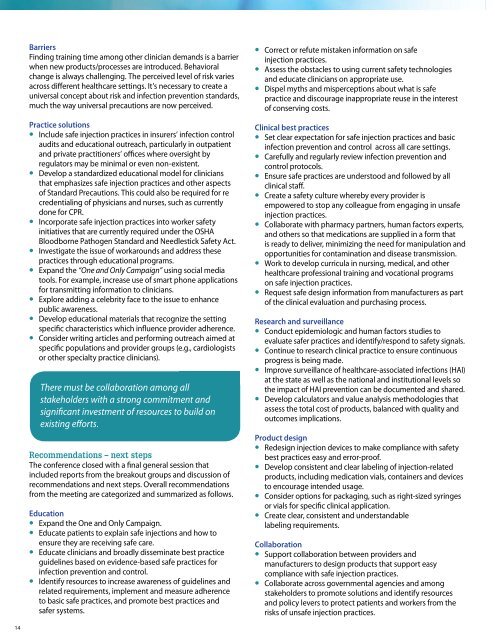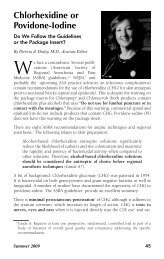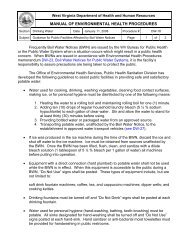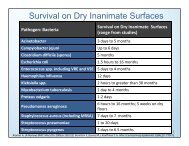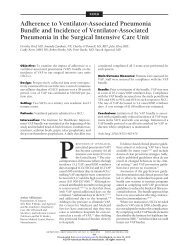Safer Designs for Safer Injections: - Premier healthcare alliance
Safer Designs for Safer Injections: - Premier healthcare alliance
Safer Designs for Safer Injections: - Premier healthcare alliance
Create successful ePaper yourself
Turn your PDF publications into a flip-book with our unique Google optimized e-Paper software.
Barriers<br />
Finding training time among other clinician demands is a barrier<br />
when new products/processes are introduced. Behavioral<br />
change is always challenging. The perceived level of risk varies<br />
across different <strong>healthcare</strong> settings. It’s necessary to create a<br />
universal concept about risk and infection prevention standards,<br />
much the way universal precautions are now perceived.<br />
Practice solutions<br />
• Include safe injection practices in insurers’ infection control<br />
audits and educational outreach, particularly in outpatient<br />
and private practitioners’ offices where oversight by<br />
regulators may be minimal or even non-existent.<br />
• Develop a standardized educational model <strong>for</strong> clinicians<br />
that emphasizes safe injection practices and other aspects<br />
of Standard Precautions. This could also be required <strong>for</strong> re<br />
credentialing of physicians and nurses, such as currently<br />
done <strong>for</strong> CPR.<br />
• Incorporate safe injection practices into worker safety<br />
initiatives that are currently required under the OSHA<br />
Bloodborne Pathogen Standard and Needlestick Safety Act.<br />
• Investigate the issue of workarounds and address these<br />
practices through educational programs.<br />
• Expand the “One and Only Campaign” using social media<br />
tools. For example, increase use of smart phone applications<br />
<strong>for</strong> transmitting in<strong>for</strong>mation to clinicians.<br />
• Explore adding a celebrity face to the issue to enhance<br />
public awareness.<br />
• Develop educational materials that recognize the setting<br />
specific characteristics which influence provider adherence.<br />
• Consider writing articles and per<strong>for</strong>ming outreach aimed at<br />
specific populations and provider groups (e.g., cardiologists<br />
or other specialty practice clinicians).<br />
There must be collaboration among all<br />
stakeholders with a strong commitment and<br />
significant investment of resources to build on<br />
existing ef<strong>for</strong>ts.<br />
Recommendations – next steps<br />
The conference closed with a final general session that<br />
included reports from the breakout groups and discussion of<br />
recommendations and next steps. Overall recommendations<br />
from the meeting are categorized and summarized as follows.<br />
Education<br />
• Expand the One and Only Campaign.<br />
• Educate patients to explain safe injections and how to<br />
ensure they are receiving safe care.<br />
• Educate clinicians and broadly disseminate best practice<br />
guidelines based on evidence-based safe practices <strong>for</strong><br />
infection prevention and control.<br />
• Identify resources to increase awareness of guidelines and<br />
related requirements, implement and measure adherence<br />
to basic safe practices, and promote best practices and<br />
safer systems.<br />
• Correct or refute mistaken in<strong>for</strong>mation on safe<br />
injection practices.<br />
• Assess the obstacles to using current safety technologies<br />
and educate clinicians on appropriate use.<br />
• Dispel myths and misperceptions about what is safe<br />
practice and discourage inappropriate reuse in the interest<br />
of conserving costs.<br />
Clinical best practices<br />
• Set clear expectation <strong>for</strong> safe injection practices and basic<br />
infection prevention and control across all care settings.<br />
• Carefully and regularly review infection prevention and<br />
control protocols.<br />
• Ensure safe practices are understood and followed by all<br />
clinical staff.<br />
• Create a safety culture whereby every provider is<br />
empowered to stop any colleague from engaging in unsafe<br />
injection practices.<br />
• Collaborate with pharmacy partners, human factors experts,<br />
and others so that medications are supplied in a <strong>for</strong>m that<br />
is ready to deliver, minimizing the need <strong>for</strong> manipulation and<br />
opportunities <strong>for</strong> contamination and disease transmission.<br />
• Work to develop curricula in nursing, medical, and other<br />
<strong>healthcare</strong> professional training and vocational programs<br />
on safe injection practices.<br />
• Request safe design in<strong>for</strong>mation from manufacturers as part<br />
of the clinical evaluation and purchasing process.<br />
Research and surveillance<br />
• Conduct epidemiologic and human factors studies to<br />
evaluate safer practices and identify/respond to safety signals.<br />
• Continue to research clinical practice to ensure continuous<br />
progress is being made.<br />
• Improve surveillance of <strong>healthcare</strong>-associated infections (HAI)<br />
at the state as well as the national and institutional levels so<br />
the impact of HAI prevention can be documented and shared.<br />
• Develop calculators and value analysis methodologies that<br />
assess the total cost of products, balanced with quality and<br />
outcomes implications.<br />
Product design<br />
• Redesign injection devices to make compliance with safety<br />
best practices easy and error-proof.<br />
• Develop consistent and clear labeling of injection-related<br />
products, including medication vials, containers and devices<br />
to encourage intended usage.<br />
• Consider options <strong>for</strong> packaging, such as right-sized syringes<br />
or vials <strong>for</strong> specific clinical application.<br />
• Create clear, consistent and understandable<br />
labeling requirements.<br />
Collaboration<br />
• Support collaboration between providers and<br />
manufacturers to design products that support easy<br />
compliance with safe injection practices.<br />
• Collaborate across governmental agencies and among<br />
stakeholders to promote solutions and identify resources<br />
and policy levers to protect patients and workers from the<br />
risks of unsafe injection practices.<br />
14


